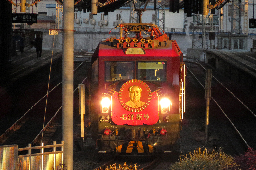Maglev (derived from magnetic levitation), is a system of train transportation that uses two sets of electromagnets: one set to repel and push the train up off the track, and another set to move the elevated train ahead, taking advantage of the lack of friction. Such trains rise approximately 10 centimetres (4 in) off the track. There are both high speed, intercity maglev systems (over 400 kilometres per hour or 250 miles per hour), and low speed, urban maglev systems (80–200 kilometres per hour or 50–124 miles per hour) being built and under construction and development.
With maglev technology, the train travels along a guideway of electromagnets which control the train's stability and speed. While the propulsion and levitation require no moving parts, the bogies can move in relation to the main body of the vehicle and some technologies require support by retractable wheels at low speeds under 150 kilometres per hour (93 mph). This compares with electric multiple units that may have several dozen parts per bogie. Maglev trains can therefore in some cases be quieter and smoother than conventional trains and have the potential for much higher speeds.
Maglev vehicles have set several speed records, and maglev trains can accelerate and decelerate much faster than conventional trains; the only practical limitation is the safety and comfort of the passengers, although wind resistance at very high speeds can cause running costs that are four to five times that of conventional high-speed rail (such as the Tokaido Shinkansen). The power needed for levitation is typically not a large percentage of the overall energy consumption of a high-speed maglev system. Overcoming drag, which makes all open-air land transport more energy intensive at higher speeds, takes the most energy. Vactrain technology has been proposed as a means to overcome this limitation. Maglev systems have been much more expensive to construct than conventional train systems, although the simpler construction of maglev vehicles makes them cheaper to manufacture and maintain.[citation needed]
The Shanghai maglev train, also known as the Shanghai Transrapid, has a top speed of 430 kilometres per hour (270 mph). The line is the fastest operational high-speed maglev train, designed to connect Shanghai Pudong International Airport and the outskirts of central Pudong, Shanghai. It covers a distance of 30.5 kilometres (19 mi) in just over 8 minutes. For the first time, the launch generated wide public interest and media attention, propelling the popularity of the mode of transportation. It is also the only maglev train in the world that can be considered as high speed.
Despite over a century of research and development, there are only six operational maglev trains today — three in China, two in South Korea, and one in Japan. Maglev can be hard to economically justify for certain locations, however it has notable benefits over conventional railway systems, which includes lower operating and maintenance costs (with zero rolling friction its parts do not wear out quickly and hence less need to replace parts often), significantly lower odds of derailment (due to its design), an extremely quiet and smooth ride for passengers, little to no air pollution, and the railcars can be built wider and make it more comfortable and spacious for passengers. And also because it can travel up higher ascending grades (up to 10 percent), compared to conventional trains (up to 4 percent or less), maglev trains can also reduce the need to create new tunnels or to level the landscape to build its tracks.
Megathreads and spaces to hang out:
- ❤️ Come listen to music and Watch movies with your fellow Hexbears nerd, in Cy.tube
- 💖 Come talk in the New Monthly queer thread
- 💛 Read about a current topic in the news
- ⭐️ October Movie Nominations ⭐️
reminders:
- 💚 You nerds can join specific comms to see posts about all sorts of topics
- 💙 Hexbear’s algorithm prioritizes struggle sessions over upbears
- 💜 Sorting by new you nerd
- 🌈 If you ever want to make your own megathread, you can go here nerd
- 🐶 Join the unofficial Hexbear-adjacent Mastodon instance toots.matapacos.dog
Links To Resources (Aid and Theory):
Aid:
- 💙Comprehensive list of resources for those in need of an abortion -- reddit link
- 💙Resources for Palestine
Theory:
Link is the first male player character to suffer from "female rpg armor syndrome"
All the best armors also make him look like a slut
New Megathread Nerds!!! :train-shining: :some-controversy:
-
🐶 Join the unofficial Hexbear-adjacent Mastodon instance toots.matapacos.dog
-
🌈 If you ever want to make your own megathread, you can go here nerd
@aaaaaaadjsf @Abraxiel @Abstraction @Acute_Engles @AnarchaPrincess @Antilope @Alaskaball @Aliveelectricwire @artificialset @bbnh69420 @BigLadKarlLiebknecht @bubbalu @buh @CatEars420 @cawsby @CDommunist @Cheesewizzard @Cherufe @ClimateChangeAnxiety @clover @Commander_Data @ComradeCmdrPiggy @ComradeEchidna @context @corgiwithalaptop @CrispyFern @Cromalin @CruciferousBodyguard @CyborgMarx @Dawn_Beveridge @Dirt_Owl @Dolores @Donut @drinkinglakewater @Dryad @ElChapoDeChapo @ElGosso @el_principito @EmmaGoldman @FALGSConaut @Flinch @flowernet @forcequit @Frogmanfromlake @GalaxyBrain @ghosts @Goadstool @GorbinOutOverHere @GoroAkechi @Grownbravy @GVAGUY3 @HarryLime @hexaflexagonbear @Hohsia @Ho_Chi_Chungus @Ideology @InevitableSwing @jabrd @JamesConeZone @Kanna @Kaputnik @Koa_lala @kristina @LesbianLiberty @marxisthayaca
@MaxOS @Mindfury @mkultrawide @Nakoichi @PaulSmackage @plinky @PM_ME_YOUR_FOUCAULTS @PorkrollPosadist @President_Obama @PurrLure @Ram_The_Manparts @Redcuban1959 @RNAi
@Rojo27 @RoseColoredVoid @solaranus @SorosFootSoldier @Sickos @silent_water @Sphere @Spike @spring_rabbit @ssjmarx @take_five_seconds @TankieTanuki @Teekeeus @Tervell
@ThisMachinePostsHog @ultraviolet @UlyssesT @Venustum @viva_la_juche @WhatDoYouMeanPodcast @Wheaties @WhyEssEff @WIIHAPPYFEW @wtypstanaccount04 @wombat @Zoift @Zuzak@thelastaxolotl @WhoaSlowDownMaurice @Quimby @Lydia
@CARCOSA @liberal @ella @all_that_is_solid @KenBonesWildRide @KiraNerys @TomboyShulk @DuckNuckem @SapGreen @Zangief @scumlord @COMMENT @Antisocial_Socialist @DOPESMOKERDENG
Remember nerds, no current struggle session discussion here on the general megathread, i will ban you from the comm and remove your comment, have a good day/night :meow-coffee:
-
CW: dating/sex having
The dating apps are going really well. I live in a small city in the midwest, not even a big place with lots of people. But I've met some cool lefties. I've ended up with a bunch of friends, like honestly most of my friends now are people I met on Tinder? And also going on lots of cute dates and having good sex. And I had never even been on a date before this year. Get on this shit comrades, its great!!
Anyways, mental health is going real good these days. Sorry to brag, but things are going well and I gotta brag somewhere.
wait what. dating apps not bad? you are required to tell me which one you're using. and how you use it :soviet-huff:
I'm on Tinder, Bumble, and Hinge. Uhh, I have like all the information filled in that I can. My political and social opinions are all clear and loudly broadcasted, I list a bunch of stuff I'm interested in, and make it clear that I'm neurodivergent. I think my pics are pretty cute. I then left swipe on like 99% of people, only swiping right on other people who actually have detailed bios and only if those bios are interesting (exception: enough piercings, tattoos, over the top makeup, or stuff like that and I'm swiping right regardless lol). Then when I match someone I usually talk to them about poetry or philosophy or something, and then end up info dumping about my mental health and stuff I'm obsessed with (people love this, unironically). If the convo is interesting I ask 'em if they wanna meet in person and suggest something. Though a lot of the time, they make this move (thankfully).
I don't really know how I pull it off tbh. I am not all that skilled socially. And before the apps nobody had ever seemed interested in me.
Get on this shit comrades, its great!!
I get nothing from dating sites :deeper-sadness:
To be fair I am a loser (by mainstream society standards) and probably can't find a woman who would be interested in me even for FWB unless I magically turn my life around. Fuckin sucks.
shoutout to people playing video games using stupid hardware that you shouldn't use to play video games
got to be one of my favorite genders
GAAAAAAAAAAAAAAAAYYYYYYYYYYYYYYY!!!!!!!!!!! :hexbear-gay-pride:
Happy Pride Month
To all the non-australians here, I want to show you one of the greatest self-owns of all time if you haven't seen it already
While being a board member for 7 media, he was also offered a partnership at PwC
https://www.afr.com/companies/media-and-marketing/ben-roberts-smith-lost-big-four-partnership-job-20210608-p57z26Not for lack of trying, including influence in reporting on the brereton report for 5 odd years
Ever just think about that time when a deadly pandemic hit, and the government gave schools a ton of money to use for upgrading HVAC systems and they just… didn’t?
Is this like when they gave ISP companies tons of money to build high speed internet infrastructure and they just said "lmao no" and kept the money
Kinda, but those ISPs turned that money into profit and stuff. A LOT of that money for schools is still just… sitting there. Idk if it never got given from the states to the schools or something but lots of it simply hasn’t been spent.
Good news, Mr. Softie didn't throw up overnight and he's been acting himself, I'm happy :meow-bounce:
Hell yeah comrade!
Give him some pets from me :meow-tankie:
Superman: "I can only reverse time for emergencies."
Me looking at my corn dog on the ground: "Superman, please."
good enough to argue with google translate but not good enough to order dinner in that country
its legitimately terrifying that people are living in countries without learning the language and using google translate to pick up the slack
i know nothing and can tell when google is completely cocking it up, how can you live with an app that is going to completely fuck up half the things you say besides stock phrases?
Takes that make me go :what-the-hell: are the norm on twitter these days. Someone just implied that jailing doctors for trans surgery “is only an extreme right position if everything is already extremely left.” Like, no it’s fucking not? You are literally advocating for a position that was the norm in Nazi Germany
When can that fucking hellsite be viewed in the same way as 4chan and stormfront?
it's the second of june and i've already seen people say kink shouldn't be at pride because uhhh aces or something (they definitely consulted ace people and are not just talking for them) yippee
being ace and disabled is the ultimate combo of people using you to advocate against your own interests
i have only ever seen this online (from queer people at least)
it strikes me as a thing that is exclusive to people who's only experience of a queer community is on the internetI never quite got this, isn't "kink at pride" just like, leather daddies? Outfits? There's no public sex acts
A decent chunk of the "no kink at pride" people are against pride in general and just use it as an excuse. I'm sure there are some well intentioned libs too, but it doesn't feel very organic.
yea!! that's why it sucks when they go "oh im just thinking of people who are sex repulsed"
motherfucker im sex repulsed and you never asked me, kink doesn't repulse me at all but the constant het shit and objectifying women in ads and shit does and no one cares enough to attack those "for" me






















